No edit summary |
Tags: VE apiedit |
||
| (38 intermediate revisions by 11 users not shown) | |||
| Line 1: | Line 1: | ||
| + | {{split}} |
||
| ⚫ | |||
| + | The following is a list of '''unnamed [[star]]s'''. |
||
| − | Classified as [[spectral type]] gamma-9, '''Sigma Draconis''' was the [[star|primary]] of the [[Sigma Draconis system|Sigma Draconis]] [[star system|system]]. |
||
| + | == By planet == |
||
| ⚫ | |||
| + | * [[Bajoran sun]] |
||
| + | * [[Cardassian sun]] |
||
| + | * [[Denevan sun]] |
||
| + | * [[Kaelon sun]] |
||
| + | * [[Monac sun]] |
||
| + | * [[Rutharian sun]] |
||
| + | * [[Tyree sun]] |
||
| + | * Primary of the [[Unnamed planets|Guardian of Forever planet]] |
||
| + | == By system == |
||
| ⚫ | |||
| + | * [[892 system]] primary |
||
| + | * [[Arcadian system]] primary |
||
| + | == Alpha and Beta Quadrants == |
||
| ⚫ | |||
| + | === Argolis Cluster star === |
||
| ⚫ | |||
| + | [[File:Argolis Cluster star.jpg|thumb|150px|A star in the Argolis Cluster]] |
||
| + | In [[2368]] the {{USS|Enterprise|NCC-1701-D|-D}} hid in the [[chromosphere]] of this [[star]]. ({{TNG|I Borg}}) |
||
| + | {{clear}} |
||
| + | |||
| + | === Arkonian planet sun === |
||
| + | An [[Unnamed Alpha and Beta Quadrant planets#Arkonian planet|unnamed planet]] claimed by the [[Arkonian]]s had a nearby sun, which caused issues for an Arkonian and [[Human]] that were stranded on a moon of the planet in [[2151]]. ({{ENT|Dawn}}) |
||
| + | |||
| + | === Badlands star === |
||
| + | [[File:Badlands star, Heart of stone.jpg|thumb|150px|A star in the Badlands]] |
||
| + | This star in the [[Badlands]] was orbited by a [[gas giant]] which itself was orbited by at least one [[Unnamed moons|moon]]. ({{DS9|Heart of Stone}}) |
||
| + | {{clear}} |
||
| + | |||
| + | === Borg renegade star === |
||
| + | [[File:Borg renegade star.jpg|thumb|150px|The star of Lore's Borg planet]] |
||
| + | In [[2370]], the {{USS|Enterprise|NCC-1701-D|-D}} lured a [[Borg type 03|rogue Borg ship]] into this star's [[corona]] and destroyed it with a [[solar flare]]. ({{TNG|Descent, Part II}}) |
||
| + | {{clear}} |
||
| + | |||
| + | === Class L planet's sun === |
||
| + | An [[Unnamed Alpha and Beta Quadrant planets#Class L planet (2373)]] where [[Odo]] and [[Quark]] crash-landed in [[2373]] had a sun that was described by Odo as not much of a sun. Despite this, it shone light on the planet. ({{DS9|The Ascent}}) |
||
| + | |||
| + | === Deinonychus system star === |
||
| + | [[File:Deinonychus VII moon and star.jpg|thumb|150px|Sun and moon of Deinonychus VII]] |
||
| + | This star was orbited by [[Deinonychus VII]]. ({{TNG|A Fistful of Datas}}) |
||
| + | {{clear}} |
||
| + | |||
| + | === Dyson sphere star === |
||
| + | [[File:Dyson sphere star.jpg|thumb|150px|A star inside a Dyson sphere]] |
||
| + | This [[G-type star]] was located at the center of a [[Dyson sphere]] discovered by the {{USS|Enterprise|NCC-1701-D|-D}} in [[2369]]. ({{TNG|Relics}}) |
||
| + | {{clear}} |
||
| + | |||
| + | === Exo III sun === |
||
| + | As of the [[23rd century]], the sun of [[Exo III's system]] had been fading for half a million years. As it did, the inhabitants moved underground. |
||
| + | {{bginfo|The sun might conceivably be named on a [[:File:Exo III profile.jpg|fact sheet]] on the planet that appeared in the episode but was unreadable on screen. The word "orbit" can be deciphered on the graphic.}} |
||
| + | |||
| + | === Kataan star system star === |
||
| + | The primary of the inhabited [[Kataan star system]] went nova approximately a thousand years before the [[2360s]]. This event was heralded by [[drought]]s on an inhabited planet in the system, [[Kataan]]. ({{TNG|The Inner Light}}) |
||
| + | |||
| + | === Klingon star === |
||
| + | [[File:Klingon star, Redemption II.jpg|thumb|150px|A star in Klingon space]] |
||
| + | In [[2368]] during the [[Klingon Civil War]], [[Kurn]] used a clever technique of engaging [[warp drive]] near this star's surface, causing a [[solar flare]] which destroyed the two [[Klingon]] pursuers. ({{TNG|Redemption II}}) |
||
| + | {{clear}} |
||
| + | |||
| + | === Kuiper belt star === |
||
| + | [[File:Kuiper belt star.jpg|thumb|150px|A star orbited by a Kuiper belt]] |
||
| + | In [[2375]] [[Odo]] and [[Weyoun#Weyoun 6|Weyoun 6]] hid from four [[Jem'Hadar attack ship]]s in the [[Kuiper belt]] of this star. ({{DS9|Treachery, Faith and the Great River}}) |
||
| + | {{clear}} |
||
| + | |||
| + | === L-class planet's sun === |
||
| + | The {{USS|Olympia}} crashed on an unnamed planet orbiting a sun. [[Captain]] [[Lisa Cusak]] survived for a time, and only after some time on the planet saw the sun rise. ({{DS9|The Sound of Her Voice}}) |
||
| + | |||
| + | === M24 Alpha system suns === |
||
| + | The [[M24 Alpha system]] had a trinary sun. ({{TOS|The Gamesters of Triskelion}}) |
||
| + | |||
| + | === Monac sun === |
||
| + | In [[2375]] [[General]] [[Martok]] and [[Lieutenant Commander]] [[Worf]] successfully destroyed the shipyards using just the {{IKS|Rotarran}}, by triggering a [[solar plasma ejection]] from a magnetic instability on the Monac sun. ({{DS9|Image in the Sand|Shadows and Symbols}}) |
||
| + | |||
| + | === Organia sun === |
||
| + | During the [[First Federation-Klingon War]], [[James T. Kirk]] tried to warn the [[Organian]]s that [[Klingon]]s would move against their planet "as surely as your sun rises". ({{TOS|Errand of Mercy}}) |
||
| + | |||
| + | === Pentarus system sun === |
||
| + | The [[Pentarus system]] had a sun, which caused very hot temperatures on the habitable [[Lamda Paz]] moon located in the system. ({{TNG|Final Mission}}) |
||
| + | |||
| + | === Psi 2000 sun === |
||
| + | The planet [[Psi 2000]], once remarkably like [[Earth]], became a frozen wasteland after its sun "went dark". ({{TOS|The Naked Time}}) |
||
| + | |||
| + | === Red giant === |
||
| + | [[File:Azati prime.jpg|thumb|A star near Azati Prime]] |
||
| + | This '''unnamed [[red giant]]''' was located at [[coordinates]] 1127.4 by 4052.0 by 3901.1 in the [[Delphic Expanse]]. It was the primary [[star]] of a [[star system]] with three planets. ({{ENT|Stratagem|Azati Prime}}) The star was studied by the [[Illyrian]]s. As such, the red giant attracted an [[Illyrian starship]] to the area, as the crewmembers aboard the vessel were curious about the star, which was the first red giant they had a chance to explore. ({{ENT|Damage}}) |
||
| + | |||
| + | {{bginfo|In the final draft script of "Stratagem", this star was described as "massive".}} |
||
| + | {{clear}} |
||
| + | |||
| + | === Risa suns === |
||
| + | [[File:Risan sunset.jpg|thumb|Binary stars setting over the [[Temtibi Lagoon]] on Risa]] |
||
| + | [[Risa]] had two suns, which were described as "hot". ({{DS9|Let He Who Is Without Sin...}}) |
||
| + | {{clear}} |
||
| + | |||
| + | === Romulan system primary === |
||
| + | [[File:Romulan system map.jpg|thumb|Romulan sun]] |
||
| + | This was the star around which [[Remus]] orbited. One side of Remus never saw the sun, and neither did [[Shinzon]] while he was exiled there. ({{film|10}}) |
||
| + | {{bginfo|Both dialogue and the graphic shown in ''Nemesis'' suggest a single sun, in contradiction to the ''[[Star Trek Maps]]'' (p. 29) and ''[[The Worlds of the Federation]]'' (p. 148), which both place the Romulan star system around a [[binary star system]] of two [[White dwarf|White dwarves]].}} |
||
| + | {{clear}} |
||
| + | |||
| + | === Sector 1156 star === |
||
| + | [[File:Sector 1156 star.jpg|thumb|150px|A star in Sector 1156]] |
||
| + | This star in [[Sector 1156]] was orbited by the [[D'Arsay archive]] which at first appeared to be a [[rogue comet]]. ({{TNG|Masks}}) |
||
| + | {{clear}} |
||
| + | |||
| + | === Sector 396 Star === |
||
| + | In [[2266]], the {{USS|Enterprise|NCC-1701-D}} rendezvoused with [[Unnamed Excelsior class starships#Haftel's transport|Haftel's transport]] near this star in [[Sector 396]]. ({{TNG|The Offspring}}) |
||
| + | |||
| ⚫ | |||
| ⚫ | |||
| + | The '''primary''' of the [[Sigma Draconis system|Sigma Draconis]] [[star system|system]] was classified as [[spectral type]] gamma-9. |
||
| + | |||
| ⚫ | |||
| ⚫ | |||
| + | |||
| ⚫ | |||
| ⚫ | |||
* {{wikipedia}} |
* {{wikipedia}} |
||
* {{ISDb|id=135800|name=Sigma Draconis}} |
* {{ISDb|id=135800|name=Sigma Draconis}} |
||
| + | {{clear}} |
||
| + | |||
| + | === Supernova of 2387 === |
||
| + | In [[2387]], a star in close proximity to [[Romulus]] went [[supernova]] and threatened the [[Milky Way Galaxy|galaxy]]. To stop the threat, [[Ambassador]] [[Spock]] used [[red matter]] to create a [[black hole]] which consumed the star's energy. Before he could successfully carry out his mission, however, the supernova reached Romulus, destroying the planet and all of its inhabitants. Among those killed were the wife and unborn child of [[Nero]], who swore vengeance against Spock, {{dis|Vulcan|planet}}, and the [[Federation]] for letting his world die. While Nero confronted Spock, both of their ships were pulled into the black hole which had consumed the star, sending them back in time and resulting in the creation of the [[alternate reality]]. ({{film|11}}) |
||
| + | |||
| + | <gallery> |
||
| + | File:2387 Supernova.jpg|A star near the Romulus system just before going supernova |
||
| + | File:Supernova approaching Romulus.jpg|The supernova approaches Romulus |
||
| + | File:Romulus Destroyed in 2387.jpg|The supernova destroys Romulus |
||
| + | </gallery> |
||
| + | |||
| + | ==== Background information ==== |
||
| + | Having a supernova threaten the entire galaxy is a physical impossibility under normal circumstances due to the laws of physics limiting its expansion rate to below the speed of light, and the expansion of the blast wave would result in it eventually dissipating, making it virtually impossible for it to cause severe damage to a warp-capable society such as the Romulan Star Empire, let alone the entire galaxy. This discrepancy was explained several different ways in non-canon works. |
||
| + | |||
| + | In the comic book series ''[[Star Trek: Countdown]]'', this star and its system were named "Hobus". The comic explained that the star's galactic threat came from its unusual ability to transform anything it contacted into energy, which it then consumed, increasing its power and causing it to expand farther and faster throughout the galaxy. |
||
| + | |||
| + | The ''{{dis|Star Trek|novel}}'' novelization instead stated that the star had merely threatened systems in its own vicinity rather than the entire galaxy. |
||
| + | |||
| + | A third explanation appears in the backstory of ''[[Star Trek Online]]'', which states that the shock wave propagated through [[subspace]] at faster-than-light speeds. Also in the game's back story, a scandal occurred several years later involving rumors that the [[Vulcan Science Academy]] knew about the instability of the star but did nothing until Spock attempted to save Romulus with the ''Jellyfish''. The scandal resulted in several resignations and sowed seeds of distrust towards the Vulcans. |
||
| + | |||
| + | It was also confirmed by the Featured Episode series "Cloaked Intentions" that Remus was also destroyed, however the Romulans and Remans still continue their prejudices towards each other. It is also revealed that the supernova was not a natural occurrence, but was engineered by then-[[Praetor]] [[Taris]], who did so under orders from the [[Iconian]]s (though she claims she was duped by her then-[[science officer]], Hakeev of the [[Tal Shiar]]). |
||
| + | |||
| + | In the more recent ''[[Stellar Cartography: The Starfleet Reference Library]]'' ("Stellar Cartography", p. 35) , the explosion of Hobus was called a "subspace supernova". This event resulted in the destruction of the entire Romulan star system, with billions killed. The cause of the explosion was unclear. The star was located in the [[Beta Quadrant]]. There was some contention on where precisely the star was located. On p. 35, the star was located in the [[Romulan Neutral Zone]]. Yet, in the "Federation Historical Highlights, 2161-2385" and "Position of the Romulan Star Empire", the star was located "southeast" of Romulus and quite some distance from the Neutral Zone. On the "Position of the Romulan Star Empire", which was a map of the [[Romulan Empire]] – prepared by the Stellar Archive Artist Lsel Essik, from the Romulan Master Data Catalog, in [[2366]] – Hobus was identified as a Romulan system. |
||
| + | |||
| + | === Tamaal's system stars === |
||
| + | [[File:Tamaal system stars.jpg|thumb|Twin stars]] |
||
| + | [[Tamaal]] was located in a binary star system. ({{ENT|Canamar}}) |
||
| + | {{clear}} |
||
| + | |||
| + | === Tkon Empire sun === |
||
| + | The [[Tkon Empire]] went extinct 600,000 years ago, according to legend because their '''sun''' went [[supernova]]. ({{TNG|The Last Outpost}}) |
||
| + | |||
| + | == Gamma Quadrant == |
||
| + | === Gaia sun === |
||
| + | The [[Gaia]] colony, which was wiped from history, had a sun. Before its erasure, [[Brota]] lamented that "Tomorrow we will see the sun rise again, but no one here will see it set". ({{DS9|Children of Time}}) |
||
| + | |||
| + | === J class gas giant star === |
||
| + | [[File:J class gas giant sun.jpg|thumb|150px|A star in the Gamma Quadrant]] |
||
| + | A [[class J planet|J class]] [[gas giant]] in the [[Gamma Quadrant]] was orbiting this sun. In [[2372]], the {{USS|Defiant|2370}} entered the atmosphere of the class J planet to rescue the crew of a [[Karemma]] ship. The Karemma were attempting to escape from two [[Jem'Hadar]] [[Jem'Hadar attack ship|ships]]. ({{DS9|Starship Down}}) |
||
| + | {{clear}} |
||
| + | |||
| + | === Meridian sun === |
||
| + | The [[planet]] {{dis|Meridian|planet}} experienced dimensional shifts, which were theorized to be somehow triggered by its '''sun'''. The sun displayed an anomaly in its fusion cycle, resulting in modulated gamma bursts. This phenomenon was studied by the {{USS|Defiant|2370}} in [[2371]], which also sent a probe into the sun's [[corona]] to gather telemetry. ({{DS9|Meridian}}) |
||
| + | |||
| + | == Delta Quadrant == |
||
| + | === Alastria twin suns === |
||
| + | [[File:Alastria twin suns.jpg|thumb|150px|The twin suns of Alastria]] |
||
| + | [[Alastria]] orbited these [[Binary star system|two suns]]. ({{VOY|Prime Factors}}) |
||
| + | {{clear}} |
||
| + | |||
| + | === Borg star === |
||
| + | [[File:Borg Star.jpg|thumb|150px|A star in Borg territory]] |
||
| + | The {{USS|Voyager}} passed by an unknown star while traveling through [[Borg]] territory. ({{VOY|The Gift}}) |
||
| + | {{bginfo|Judging from the color, the [[Spectral class]] of this star may be A0 or it may be a [[white dwarf]].}} |
||
| + | {{clear}} |
||
| + | |||
| + | === Class D planet star === |
||
| + | [[File:Class D planet sun.jpg|thumb|150px|A sun orbited by a class D planet]] |
||
| + | This [[Unnamed stars|star]] was orbited by a [[class D]] [[planet]] encountered by the {{USS|Voyager}} in the [[Delta Quadrant]] in [[2371]]. ({{VOY|Emanations}}) |
||
| + | {{clear}} |
||
| + | |||
| + | === Ocampan sun === |
||
| + | [[File:Ocampan sun.jpg|thumb|150px|The Ocampan sun]] |
||
| + | The [[planet]] {{dis|Ocampa|planet}} orbited this [[G-type star]]. ({{VOY|Caretaker}}) |
||
| + | {{clear}} |
||
| + | |||
| + | === Star near rogue comet === |
||
| + | [[File:Star near rogue comet, Death wish.jpg|thumb|150px|A star in the Delta Quadrant]] |
||
| + | In [[2372]], the crew of the {{USS|Voyager}} encountered the [[rogue comet]] housing [[Quinn]] close to this star. ({{VOY|Death Wish}}) |
||
| + | {{clear}} |
||
| + | |||
| + | === Star in Swarm species space === |
||
| + | [[File:Star in Swarm space.jpg|thumb|150px|A star in Swarm species space]] |
||
| + | This star was located in or close to [[Swarm species]] space. It was orbited by at least one [[Unnamed Delta Quadrant planets|planet]]. [[Tom Paris]] and [[B'Elanna Torres]] investigated the star system in a [[shuttle]] in [[2373]]. ({{VOY|The Swarm}}) |
||
| + | {{clear}} |
||
| + | |||
| + | === Supernova of 2373 (natural) === |
||
| + | [[File:Supernova star 1, The Q and the grey.jpg|thumb|150px|A star in the Delta Quadrant]] |
||
| + | This star went [[supernova|nova]] in [[2373]]. The rare event was observed by the the crew of the {{USS|Voyager}}. ({{VOY|The Q and the Grey}}) |
||
| + | {{clear}} |
||
| + | |||
| + | === Supernova of 2373 (caused by Q) === |
||
| + | [[File:Supernova star 2, The Q and the grey.jpg|thumb|150px|A star in the Delta Quadrant]] |
||
| + | This star went [[supernova|nova]] in [[2373]]. The supernova was caused by the [[Q Civil War]]. The {{USS|Voyager}} entered the [[Q Continuum]] through this supernova. ({{VOY|The Q and the Grey}}) |
||
| + | {{clear}} |
||
| − | [[ |
+ | [[nl:Naamloze sterren]] |
| + | [[Category:Lists|Stars]] |
||
| ⚫ | |||
| − | [[Category:Stars]] |
+ | [[Category:Stars| Unnamed]] |
Revision as of 12:18, 19 April 2016
The following is a list of unnamed stars.
By planet
- Bajoran sun
- Cardassian sun
- Denevan sun
- Kaelon sun
- Monac sun
- Rutharian sun
- Tyree sun
- Primary of the Guardian of Forever planet
By system
- 892 system primary
- Arcadian system primary
Alpha and Beta Quadrants
Argolis Cluster star
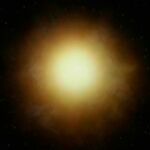
A star in the Argolis Cluster
In 2368 the USS Enterprise-D hid in the chromosphere of this star. (TNG: "I Borg")
Arkonian planet sun
An unnamed planet claimed by the Arkonians had a nearby sun, which caused issues for an Arkonian and Human that were stranded on a moon of the planet in 2151. (ENT: "Dawn")
Badlands star
A star in the Badlands
This star in the Badlands was orbited by a gas giant which itself was orbited by at least one moon. (DS9: "Heart of Stone")
Borg renegade star
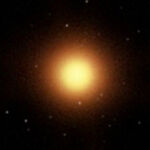
The star of Lore's Borg planet
In 2370, the USS Enterprise-D lured a rogue Borg ship into this star's corona and destroyed it with a solar flare. (TNG: "Descent, Part II")
Class L planet's sun
An Unnamed Alpha and Beta Quadrant planets#Class L planet (2373) where Odo and Quark crash-landed in 2373 had a sun that was described by Odo as not much of a sun. Despite this, it shone light on the planet. (DS9: "The Ascent")
Deinonychus system star
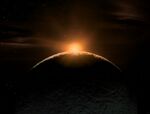
Sun and moon of Deinonychus VII
This star was orbited by Deinonychus VII. (TNG: "A Fistful of Datas")
Dyson sphere star
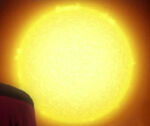
A star inside a Dyson sphere
This G-type star was located at the center of a Dyson sphere discovered by the USS Enterprise-D in 2369. (TNG: "Relics")
Exo III sun
As of the 23rd century, the sun of Exo III's system had been fading for half a million years. As it did, the inhabitants moved underground.
Kataan star system star
The primary of the inhabited Kataan star system went nova approximately a thousand years before the 2360s. This event was heralded by droughts on an inhabited planet in the system, Kataan. (TNG: "The Inner Light")
Klingon star
A star in Klingon space
In 2368 during the Klingon Civil War, Kurn used a clever technique of engaging warp drive near this star's surface, causing a solar flare which destroyed the two Klingon pursuers. (TNG: "Redemption II")
Kuiper belt star
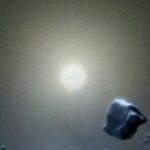
A star orbited by a Kuiper belt
In 2375 Odo and Weyoun 6 hid from four Jem'Hadar attack ships in the Kuiper belt of this star. (DS9: "Treachery, Faith and the Great River")
L-class planet's sun
The USS Olympia crashed on an unnamed planet orbiting a sun. Captain Lisa Cusak survived for a time, and only after some time on the planet saw the sun rise. (DS9: "The Sound of Her Voice")
M24 Alpha system suns
The M24 Alpha system had a trinary sun. (TOS: "The Gamesters of Triskelion")
Monac sun
In 2375 General Martok and Lieutenant Commander Worf successfully destroyed the shipyards using just the IKS Rotarran, by triggering a solar plasma ejection from a magnetic instability on the Monac sun. (DS9: "Image in the Sand", "Shadows and Symbols")
Organia sun
During the First Federation-Klingon War, James T. Kirk tried to warn the Organians that Klingons would move against their planet "as surely as your sun rises". (TOS: "Errand of Mercy")
Pentarus system sun
The Pentarus system had a sun, which caused very hot temperatures on the habitable Lamda Paz moon located in the system. (TNG: "Final Mission")
Psi 2000 sun
The planet Psi 2000, once remarkably like Earth, became a frozen wasteland after its sun "went dark". (TOS: "The Naked Time")
Red giant

A star near Azati Prime
This unnamed red giant was located at coordinates 1127.4 by 4052.0 by 3901.1 in the Delphic Expanse. It was the primary star of a star system with three planets. (ENT: "Stratagem", "Azati Prime") The star was studied by the Illyrians. As such, the red giant attracted an Illyrian starship to the area, as the crewmembers aboard the vessel were curious about the star, which was the first red giant they had a chance to explore. (ENT: "Damage")
Risa suns
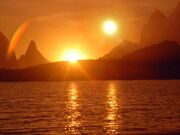
Binary stars setting over the Temtibi Lagoon on Risa
Risa had two suns, which were described as "hot". (DS9: "Let He Who Is Without Sin...")
Romulan system primary

Romulan sun
This was the star around which Remus orbited. One side of Remus never saw the sun, and neither did Shinzon while he was exiled there. (Star Trek Nemesis)
Sector 1156 star
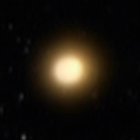
A star in Sector 1156
This star in Sector 1156 was orbited by the D'Arsay archive which at first appeared to be a rogue comet. (TNG: "Masks")
Sector 396 Star
In 2266, the USS Enterprise rendezvoused with Haftel's transport near this star in Sector 396. (TNG: "The Offspring")
Sigma Draconis star

The Sigma Draconis primary
The primary of the Sigma Draconis system was classified as spectral type gamma-9.
The position of this yellow dwarf star was depicted on a system map that was displayed on the main viewscreen of the USS Enterprise bridge in 2268. (TOS: "Spock's Brain")
External links
- Unnamed Alpha and Beta Quadrant stars at Memory Beta, the wiki for licensed Star Trek works
- Unnamed Alpha and Beta Quadrant stars at Wikipedia
- Sigma Draconis at the Internet Stellar Database
Supernova of 2387
In 2387, a star in close proximity to Romulus went supernova and threatened the galaxy. To stop the threat, Ambassador Spock used red matter to create a black hole which consumed the star's energy. Before he could successfully carry out his mission, however, the supernova reached Romulus, destroying the planet and all of its inhabitants. Among those killed were the wife and unborn child of Nero, who swore vengeance against Spock, Vulcan, and the Federation for letting his world die. While Nero confronted Spock, both of their ships were pulled into the black hole which had consumed the star, sending them back in time and resulting in the creation of the alternate reality. (Star Trek)
Background information
Having a supernova threaten the entire galaxy is a physical impossibility under normal circumstances due to the laws of physics limiting its expansion rate to below the speed of light, and the expansion of the blast wave would result in it eventually dissipating, making it virtually impossible for it to cause severe damage to a warp-capable society such as the Romulan Star Empire, let alone the entire galaxy. This discrepancy was explained several different ways in non-canon works.
In the comic book series Star Trek: Countdown, this star and its system were named "Hobus". The comic explained that the star's galactic threat came from its unusual ability to transform anything it contacted into energy, which it then consumed, increasing its power and causing it to expand farther and faster throughout the galaxy.
The Star Trek novelization instead stated that the star had merely threatened systems in its own vicinity rather than the entire galaxy.
A third explanation appears in the backstory of Star Trek Online, which states that the shock wave propagated through subspace at faster-than-light speeds. Also in the game's back story, a scandal occurred several years later involving rumors that the Vulcan Science Academy knew about the instability of the star but did nothing until Spock attempted to save Romulus with the Jellyfish. The scandal resulted in several resignations and sowed seeds of distrust towards the Vulcans.
It was also confirmed by the Featured Episode series "Cloaked Intentions" that Remus was also destroyed, however the Romulans and Remans still continue their prejudices towards each other. It is also revealed that the supernova was not a natural occurrence, but was engineered by then-Praetor Taris, who did so under orders from the Iconians (though she claims she was duped by her then-science officer, Hakeev of the Tal Shiar).
In the more recent Stellar Cartography: The Starfleet Reference Library ("Stellar Cartography", p. 35) , the explosion of Hobus was called a "subspace supernova". This event resulted in the destruction of the entire Romulan star system, with billions killed. The cause of the explosion was unclear. The star was located in the Beta Quadrant. There was some contention on where precisely the star was located. On p. 35, the star was located in the Romulan Neutral Zone. Yet, in the "Federation Historical Highlights, 2161-2385" and "Position of the Romulan Star Empire", the star was located "southeast" of Romulus and quite some distance from the Neutral Zone. On the "Position of the Romulan Star Empire", which was a map of the Romulan Empire – prepared by the Stellar Archive Artist Lsel Essik, from the Romulan Master Data Catalog, in 2366 – Hobus was identified as a Romulan system.
Tamaal's system stars

Twin stars
Tamaal was located in a binary star system. (ENT: "Canamar")
Tkon Empire sun
The Tkon Empire went extinct 600,000 years ago, according to legend because their sun went supernova. (TNG: "The Last Outpost")
Gamma Quadrant
Gaia sun
The Gaia colony, which was wiped from history, had a sun. Before its erasure, Brota lamented that "Tomorrow we will see the sun rise again, but no one here will see it set". (DS9: "Children of Time")
J class gas giant star
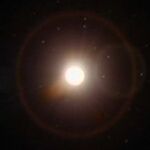
A star in the Gamma Quadrant
A J class gas giant in the Gamma Quadrant was orbiting this sun. In 2372, the USS Defiant entered the atmosphere of the class J planet to rescue the crew of a Karemma ship. The Karemma were attempting to escape from two Jem'Hadar ships. (DS9: "Starship Down")
Meridian sun
The planet Meridian experienced dimensional shifts, which were theorized to be somehow triggered by its sun. The sun displayed an anomaly in its fusion cycle, resulting in modulated gamma bursts. This phenomenon was studied by the USS Defiant in 2371, which also sent a probe into the sun's corona to gather telemetry. (DS9: "Meridian")
Delta Quadrant
Alastria twin suns

The twin suns of Alastria
Alastria orbited these two suns. (VOY: "Prime Factors")
Borg star

A star in Borg territory
The USS Voyager passed by an unknown star while traveling through Borg territory. (VOY: "The Gift")
Class D planet star
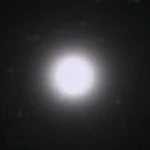
A sun orbited by a class D planet
This star was orbited by a class D planet encountered by the USS Voyager in the Delta Quadrant in 2371. (VOY: "Emanations")
Ocampan sun
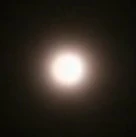
The Ocampan sun
The planet Ocampa orbited this G-type star. (VOY: "Caretaker")
Star near rogue comet
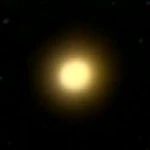
A star in the Delta Quadrant
In 2372, the crew of the USS Voyager encountered the rogue comet housing Quinn close to this star. (VOY: "Death Wish")
Star in Swarm species space
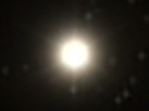
A star in Swarm species space
This star was located in or close to Swarm species space. It was orbited by at least one planet. Tom Paris and B'Elanna Torres investigated the star system in a shuttle in 2373. (VOY: "The Swarm")
Supernova of 2373 (natural)
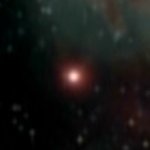
A star in the Delta Quadrant
This star went nova in 2373. The rare event was observed by the the crew of the USS Voyager. (VOY: "The Q and the Grey")
Supernova of 2373 (caused by Q)

A star in the Delta Quadrant
This star went nova in 2373. The supernova was caused by the Q Civil War. The USS Voyager entered the Q Continuum through this supernova. (VOY: "The Q and the Grey")


